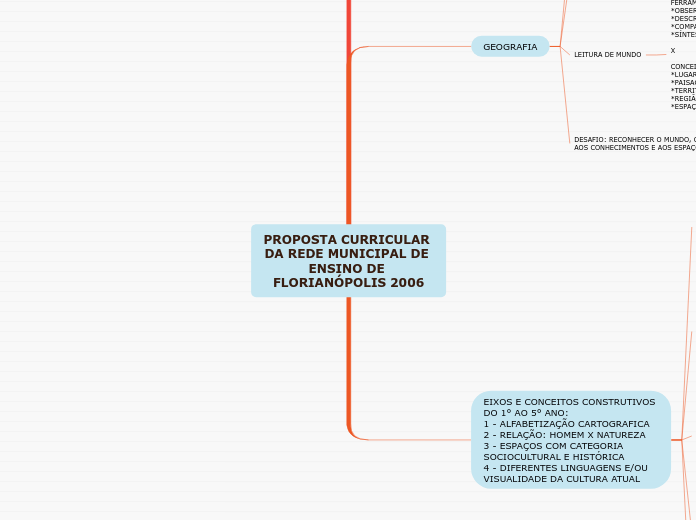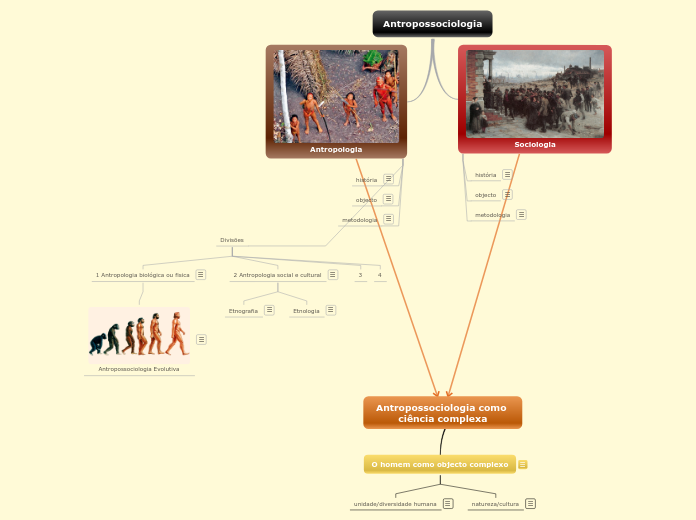PROPOSTA CURRICULAR DA REDE MUNICIPAL DE ENSINO DE FLORIANÓPOLIS 2006
To name your story, you have to think about the overall message and what you want your audience to understand from the story. Also, make it relevant and easy to remember.
EIXOS E CONCEITOS CONSTRUTIVOS DO 1° AO 5° ANO:
1 - ALFABETIZAÇÃO CARTOGRAFICA
2 - RELAÇÃO: HOMEM X NATUREZA
3 - ESPAÇOS COM CATEGORIA SOCIOCULTURAL E HISTÓRICA
4 - DIFERENTES LINGUAGENS E/OU VISUALIDADE DA CULTURA ATUAL
The ending of a story is essential. We all know that if the ending is weak, what happened before loses its importance. So make it unpredictable, but fair. A resolved ending answers all the questions and ties up any loose threads from the plot.
5° ANO
1 - CRIAR MAPAS, CROQUIS, MAQUETES E DESENHOS COMO FORMA DE REPRESENTAR O ESPAÇO VIVIDO
2 - PERCEBER AS TRANSFORMAÇÕES NATURAIS E AS CAUSADAS PELO HOMEM EM FPOLIS
3 - IDENTIFICAR SITUAÇÕES LOCAIS ESTABELECENDO RELAÇÕES DE PERMANENCIA E MUDANÇA ENTRE PASSADO E PRESENTE
4 - INFERIR O CONTEUDO DE UM TEXTO COM BASE NA ANALISE DE OBRAS DE ARTE QUE APRESENTEM ASPECTOS NATURAIS, URBANOS, SOCIAIS E CULTURAL DO bRASIL
4° ANO
1 - COMPARAR DIFERENTES FORMAS DE REPRESENTAÇÕES DO ESPAÇO
2 - RECONHECER A IMPORTÂNCIA NO PROCESSO DE PRESERAÇÃO
3 - IDENTIFICAR O TERRITÓRIO COMO CONSTRUÇÃO HUMANA A LONGO PRAZO
4 - APROPRIAR-SE DE ELEMENTOS DE DESCRIÇÃO E OBSERVAÇÕES PESSOAIS DE LEITURA DE PAISAGEM
3³ ANO
1 - OBSERVAR, IDENTIFICAR E LOCALIZAR PONTOS DE REFERÊNCIA E COM ISSO RECONHECER A DISTÂNCIA ENTRE LUGARES
2 - COMPREENDER O CONCEITO DE PAISAGEM: NATUREZA x MODIFICAÇÃO E RURAL x URBANO
3 - IDENTIFICAR PAISAGENS DOS LUGARES ESTABELECENDO DIFERENÇAS E SEMELHANÇAS
4 - ANALISE DE FOTOS E MAPAS ANTIGOS DE FPOLIS E COMPARAÇÃO COM A ATUALIDADE
2° ANO
1 - RECONHECER E APLICAR RECURSOS DE OBSERVAÇÃO, PERCEPÇÃO E ORIENTAÇÃO ESPACIAL
2 - COMPREENDER QUE A NATUREZA E SEUS SISTEMAS SÃO ESSECIAIS
3 - IDENTIFICAR AS DIFERENÇAS E SEMELHANÇAS ENTRE MODOS DE SER CRIANÇA EM CULTURAS E LUGARES DIFERENTES DOS SEUS DE VIVÊNCIA
4 - CONHECER E USAR LITERATURAS INFANTIS, COMPREENDENDO POR MEIO DELAS AS DIFERENTES PAISAGENS DAS CIDADES
1° ANO
1 - DEFINIR AS DIVERSAS FORMAS DE COMO AS CRIANÇAS REPRESENTAM E PERCEBEM O ESPAÇO
2 - COMPREENDER QUE A RELAÇÃO HOMEM X NATUREZA, INTERFEREM NA PAISAGEM E QUALIDADE DE VIDA
3 - COMPREENDER O QUE É SER CRIANÇA A PARTIR DO SEU PRÓPRIO MODO DE VIDA
4 - RECONHECER DIFERENTES FONTES DE REGISTROS DE PAISAGENS
GEOGRAFIA
The middle of the story is where you add layers of complications that will lead to the end. Reveal more about the character's journey. Did their personality go through changes? How did they overcome the challenges? And as you build up the story’s central conflict, make it more personal to that character. Also, from the middle act, you have to lead into the final act.
DESAFIO: RECONHECER O MUNDO, CONECTADOS AOS CONHECIMENTOS E AOS ESPAÇOS VIVIDOS
ESPAÇO VIVIDO: SÃO LUGARES CONSTRUIDOS E QUE RESULTAM DA HISTÓRIA DAS PESSOAS E DOS GRUPOS SOCIAIS QUE EXISTEM, MAS POSSUI INTERFERÊNCIAS VINDA DE OUTROS LUGARES, COMPREENDIDOS COMO REGIÃO, NAÇÃO E TERRITÓRIO
LEITURA DE MUNDO
FERRAMENTAS DE ANALISE
*OBSERVAÇÃO
*DESCRIÇÃO
*COMPARAÇÃO
*SÍNTESE
X
CONCEITOS CHAVE DA ÁREA
*LUGAR
*PAISAGEM
*TERRITÓRIO
*REGIÃO
*ESPAÇO
LER E ESCREVER EM GEOGRAFIA SIGNIFICA TER UM DOMINIO DA LINGUAGEM CARTOGRAFICA
LINGUAGEM CARTOGRAFICA: DOMINAR A LEITURAS DE MAPAS, CROQUIS, MAQUETES POR MEIO DE SIGNOS E SIMBOLOS
OBJETO DE ESTUDO:
*ESPAÇO GEOGRAFICO
Your character(s) need(s) motivation in order to solve the challenge(s).
ESPAÇO ESSE QUE É DENSO, COMPLEXO E ORGANIZADO A PARTIR DAS FORMAS NATURAIS E TRANSFORMADO PELA TÉCNICA
Secondary characters also might have motivs beacuse of which they may cross path with main character or which might trigger them to help the main character.
GERA CONTRADIÇÕES E CONFLITOS
VIVE EM CONSTANTE MUDANÇA
PENSADA PELA SOCIEDADE
CRIANÇA É UM SER:
*SOCIOCULTURAL
*HISTÓRICO
*GEOGRAFICO
Each story has a main character and that character usually needs to solve a problem or challenge. The character's challenge is the one that creates tension throughout the story.
CIÊNCIAS HUMANAS: GEOGRAFIA E HISTÓRIA
In the beginning of the story (or the exposition), you will need to introduce the setting and characters. You might also want to introduce the main conflict. This part of the story is important because it gives the reader necessary background information and maybe even a first insight into a character’s personality.
COMPREENSÃO DO AMBIENTE
RELAÇÔES SOCIAIS
SER HUMANO ENTRE SI
SER HUMANO E NATUREZA
COMPREENSÃO DA REALIDADE
PROCESSO DE INSERÇÃO
SUJEITO SOCIAL
EDUCAÇÃO
The setting (time & place) of a story can change throughout the plot.
REVISÃO DE DIREITOS
The time of the story can also change. It can describe the event of a single day or can include an entire year's plot. Anyway, don't forget to mention it.
ESTUDANTE COMO SUJEITO CENTRAL DE APRENDIZAGEM
EDUCAÇÃO TECNICISTA
Characters are essential to a good story. Usually, the protagonist(s) is/are the most affected by the plot. Introduce a character by focusing on their actions, interests, and occupation, as the physical appearance doesn't make a difference in most cases.









